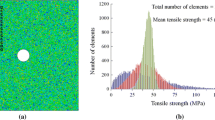The article presents a detailed finite-element model for investigating hydraulic fracture propagation in weakly consolidated sandstone. Elastoplastic deformation of the rock matrix, pore fluid flow, initiation and propagation of hydraulic fractures as well as flow of fracturing fluid within a fracture and leakoff into the formation are considered interdependently. The extended Cam-Clay model is used to achieve a more precise assessment of the mechanical behavior of weakly consolidated sandstone. Parametric studies are performed to investigate the effect of the fracturing parameters on the fracture patterns. The numerical results show that extremely short and narrow fractures are formed if low-efficiency fracturing fluid is used to initiate fractures in weakly consolidated sandstone with a zone of shear dilation formed on both faces of the fracture. In contrast, longer and wider fractures initiation of which is desirable in frac-pack (hydraulic fracturing) operations with the use of proppant may be obtained with the use of high- efficiency fracturing fluid and more compact zones are created near the fracture. However, the structure of the compaction zone produces an insignificant decrease in permeability. It is also shown that plastic deformation of the rock matrix has a significant impact on the geometry of a fracture, and this must be taken into account in the design of frac-pack operations with the use of proppant in weakly consolidated sandstone reservoirs.











Similar content being viewed by others
References
J. Ayoub, J. Kirksey, B. Malone, et al., Hydraulic fracturing of soft formations in the gulf coast, in: SPE Formation Damage Control Symposium, Lafeyette, Illinois, USA, Feburary 26–27, 1992; SPE 23805
M. Khodaverdian and P. McElfresh, Hydraulic fracturing stimulation in poorly consolidated sand: mechanisms and consequences, in SPE Annual Technical Conf., Dallas, Texas, USA, October 1–4, 2000; SPE63233
H. Jasarevic, E. Golovin, A. Chudnovsky, et al., Observation and modeling of hydraulic fracture initiation in cohesiveless sand, in: 44th US Rock Mechanics Symposium and 5th US–Canada Rock Mechanics Symposium, Salt Lake City, Utah, USA, June 27–30, 2010; ARMA 10-360
C. J. de Pater and Y. Dong, Experimental study of hydraulic fracturing in sand as a function of stress and fluid rheology, in: SPE Hydraulic Fracturing Technology Conference, College Station, Texas, USA, January 29–31, 2007; SPE105620
L. N. Germanovich, R. S. Hurt, J. A. Ayoub, et al., Experimental study of hydraulic fracturing in unconsolidated materials, in: SPE International Symposium and Exhibition on Formation Damage Control, Lafayette, Louisiana, USA, February 15–17, 2012; SPE151827
J. Deng, J. Wang and J. Yan, Study on propagation law of hydraulic fractures of gas pool in unconsolidated sandstone, Rock and Soil Mechanics, 23, No. 1, 72–74 (2002).
B. Xu and R. C. Wong, A 3D finite element model for history matching hydraulic fracturing in unconsolidated sands formation, Journal of Canadian Petroleum Technology, 49, No. 4, 58–66 (2010).
Z. Zhai and M. M. Sharma, A new approach to modeling hydraulic fractures in unconsolidated sands, in: SPE Annual Technical Conference and Exhibition, Dallas, Texas, USA, October 9–12, 2005; SPE96246
P. Papanastasiou, The influence of plasticity in hydraulic fracturing, International Journal of Fracture, 84, No. 1, 61–79 (1997).
D. Lee and M. M. Sharma, A fully-coupled, poro-elasto-plastic, 3-D model for frac-pack treatments in poorly consolidated sands, in: SPE Hydraulic Fracturing Technology Conference and Exhibition, The Woodlands, Texas, USA, January 24–26; SPE184847
A. Abou-Sayed, K. Zaki, G. Wang, et al., Fracture propagation and formation disturbance during injection and Frac-Pack operations in soft compacting rocks, in: SPE Annual Technical Conference and Exhibition, Houston, Texas, USA, September 26–29, 2004; SPE90656
S. Yuan and J. Harrison, Propagation of a hydro-mechanical local degradation approach and its application to modelling fluid flow during progressive fracturing of heterogeneous rocks.” International Journal of Rock Mechanics and Mining Sciences, 42, No. 7, 961–984 (2005)
The authors wish to acknowledge the financial support provided by the National Science and Technology Major Project (No. 2016ZX05058-002-006).
Author information
Authors and Affiliations
Additional information
Translated from Khimiya i Tekhnologiya Topliv i Masel, No. 6, pp. 85 – 92, November – December, 2017.
Rights and permissions
About this article
Cite this article
Fan, B., Deng, J., Lin, H. et al. Numerical Simulation of Hydraulic Fracturing in Weakly Consolidated Sandstone. Chem Technol Fuels Oils 53, 943–955 (2018). https://doi.org/10.1007/s10553-018-0884-0
Published:
Issue Date:
DOI: https://doi.org/10.1007/s10553-018-0884-0




